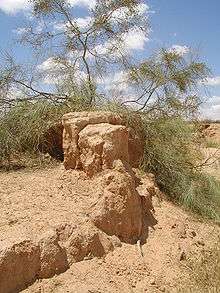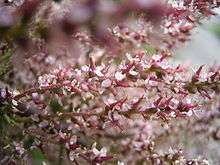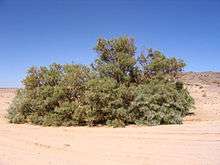Tamarix
The genus Tamarix (tamarisk, salt cedar) is composed of about 50–60 species of flowering plants in the family Tamaricaceae, native to drier areas of Eurasia and Africa.[2] The generic name originated in Latin and may refer to the Tamaris River in Hispania Tarraconensis (Spain).[3]
| Tamarix | |
|---|---|
 | |
| Tamarix aphylla in its natural habitat in Revivim, Israel | |
| Scientific classification | |
| Kingdom: | Plantae |
| Clade: | Tracheophytes |
| Clade: | Angiosperms |
| Clade: | Eudicots |
| Order: | Caryophyllales |
| Family: | Tamaricaceae |
| Genus: | Tamarix L.[1] |
| Species | |
|
See text | |
Description
They are evergreen or deciduous shrubs or trees growing to 1–18 m in height and forming dense thickets. The largest, Tamarix aphylla, is an evergreen tree that can grow to 18 m tall. They usually grow on saline soils, tolerating up to 15,000 ppm soluble salt and can also tolerate alkaline conditions.
Tamarisks are characterized by slender branches and grey-green foliage. The bark of young branches is smooth and reddish brown. As the plants age, the bark becomes bluish-purple, ridged and furrowed.
The leaves are scale-like, almost like that of junipers,[4] 1–2 mm long, and overlap each other along the stem. They are often encrusted with salt secretions.
The pink to white flowers appear in dense masses on 5–10 cm long spikes at branch tips from March to September, though some species (e.g., T. aphylla) tend to flower during the winter.
Reproduction
Tamarix can spread both vegetatively, by adventitious roots or submerged stems, and sexually, by seeds. Each flower can produce thousands of tiny (1 mm diameter) seeds that are contained in a small capsule usually adorned with a tuft of hair that aids in wind dispersal. Seeds can also be dispersed by water. Seedlings require extended periods of soil saturation for establishment. Tamarisk trees are most often propagated by cuttings.
Tamarix species are fire-adapted, and have long tap roots that allow them to intercept deep water tables and exploit natural water resources. They are able to limit competition from other plants by taking up salt from deep ground water, accumulating it in their foliage, and from there depositing it in the surface soil where it builds up concentrations temporarily detrimental to some plants. The salt is washed away during heavy rains.
Tamarix species are used as food plants by the larvae of some Lepidoptera species including Coleophora asthenella which feeds exclusively on T. africana.
Uses
- Tamarisk species are used as ornamental shrubs, windbreaks, and shade trees: notably T. ramosissima and T. tetrandra
- This wood was used by the Saka (combined with wood and ibex horn) to produce tremendously powerful bows hundreds of years before the common era. [5]
- The wood may be used for carpentry or firewood: it is a possible agroforestry species[6][7]
- Plans are being made for the tamarisk to play a role in antidesertification programs in China[8][9]
- Salt cedars can be planted to mine salts, then be used in the production of fuel and fertilizer (although the latter will be somewhat salty)[10]
Invasive species
Tamarix ramosissima has naturalized and become a major invasive plant species in parts of the world, such as in the Southwestern United States and Desert Region of California, consuming large amounts of groundwater in riparian and oasis habitats due to the density of its stands. The high salt level in tamarisk infiltrates the soil, preventing other plants from growing, creating a tamarisk-dominant forest with no understory, void of important habitat for pollinators and other native species. Tamarisk forests also tend to burn hotter than most native riparian trees, worsening the fire hazard of acres of uninterrupted tamarisk and their risk to human structures.
Tamarisk eradication projects use a combination of methods, including manual stem cutting followed by application of herbicide to the stump and burning.
Selected species


- Tamarix africana Poir.
- Tamarix androssowii
- Tamarix aphylla (L.) H.Karst.
- Tamarix arceuthoides
- Tamarix articulata
- Tamarix austromongolica
- Tamarix boveana
- Tamarix canariensis
- Tamarix chinensis Lour.
- Tamarix dalmatica
- Tamarix dioica Roxb. ex Roth
- Tamarix duezenlii
- Tamarix elongata
- Tamarix gallica L.
- Tamarix gansuensis
- Tamarix gracilis Willd.
- Tamarix hampeana
- Tamarix hispida Willd.
- Tamarix indica
- Tamarix jintaenia
- Tamarix juniperina
- Tamarix jordanis
- Tamarix karelinii Bunge
- Tamarix laxa Willd.
- Tamarix leptostachys
- Tamarix mannifera (Ehrenb.) Bunge
- Tamarix mongolica
- Tamarix negevensis
- Tamarix nilotica
- Tamarix parviflora DC.
- Tamarix ramosissima Ledeb.
- Tamarix sachuensis
- Tamarix senegalensis DC.
- Tamarix smyrnensis Bunge (=T. hohenackeri)
- Tamarix taklamakanensis
- Tamarix tarimensis
- Tamarix tenuissima
- Tamarix tetragyna Ehrenb.
- Tamarix tetragyna var. meyeri (Boiss.) Boiss. (=T. meyeri)
- Tamarix tetragyna var. tetragyna
- Tamarix tetrandra Pall. ex M.Bieb.[11]
- Tamarix usneoides E.Mey. ex Bunge
Formerly placed here
- Myricaria germanica (L.) Desv. (as T. germanica L.)[11]
Tamarisk in North America
The tamarisk was introduced to the United States as an ornamental shrub, a windbreak, and a shade tree in the early 19th century. In the 1930s, during the Great Depression, tree-planting was used as a tool to fight soil erosion on the Great Plains, and the trees were planted by the millions in the Great Plains Shelterbelt.[12][13]
Eight species are found in North America. They can be divided into two subgroups:
- Evergreen species
Tamarix aphylla (Athel tree), a large evergreen tree, does not sexually reproduce in the local climate and is not considered a seriously invasive species. The Athel tree is commonly used for windbreaks on the edge of agricultural fields and as a shade tree in the deserts of the Southwestern United States.
- Deciduous species
The second subgroup contains the deciduous tamarisks, which are small, shrubby trees, commonly known as "saltcedars". These include Tamarix pentandra, Tamarix tetranda, Tamarix gallica, Tamarix chinensis, Tamarix ramosissima, and Tamarix parvifolia.[14]
These deciduous trees establish themselves in disturbed and undisturbed streams, waterways, bottom lands, banks, and drainage washes of natural or artificial water bodies, moist rangelands and pastures, and other areas where seedlings can be exposed to extended periods of saturated soil for establishment.
Invasive species
Tamarix species are commonly believed to disrupt the structure and stability of North American native plant communities and degrade native wildlife habitat, by outcompeting and replacing native plant species, salinizing soils, monopolizing limited sources of moisture, and increasing the frequency, intensity, and effect of fires and floods. While individual plants may not consume larger quantities of water than native species,[15][16] large, dense stands of tamarisk do consume more water than equivalent stands of native cottonwoods.[17] An active and ongoing debate exists as to when the tamarisk can out-compete native plants, and if it is actively displacing native plants or it just taking advantage of disturbance by removal of natives by humans and changes in flood regimens.[18][19][20][21][22] Research on competition between tamarisk seedlings and co-occurring native trees has found that the seedlings are not competitive over a range of environments,[23](Sher, Marshall & Taylor 2002)[24] but stands of mature trees effectively prevent native species' establishment in the understory, due to low light, elevated salinity, and possibly changes to the soil biota.[25][26] Box elder (Acer negundo, a native riparian tree) seedlings survive and grow under higher-shade conditions than Tamarix seedlings, and mature Tamarix specimens die after 1–2 years of 98% shade, indicating a pathway for successional replacement of Tamarix by box elder.[27] Anthropogenic activities that preferentially favor tamarisk (such as changes to flooding regimens) are associated with infestation.[28] To date, Tamarix has taken over large sections of riparian ecosystems in the western United States that were once home to native cottonwoods and willows,[29] and are projected by some to spread well beyond the current range.[30]
Controls
Pest populations of tamarisk in the United States can be dealt with in several ways. The National Park Service has used the methods of physically removing the plants, spraying them with herbicides, and introducing northern tamarisk beetles (Diorhabda carinulata) in the national park system. This has been done in the Dinosaur National Monument in Utah and Colorado along the Green and Yampa Rivers, during the summers of 2006 and 2007.[31] After years of study, the USDA Agricultural Research Service has found that the tamarisk beetles eat only the tamarisk, and starve when no more tamarisk is available. No other native North American plants have been found to be eaten by the introduced tamarisk beetle. Progress is slow, but proves that containment of the tamarisk is possible in the long term.[32]
Cultural history
In the Epic of Gilgamesh, Gilgamesh's mother, the goddess Ninsun, ceremoniously bathes in a bath of "tamarisk" and soapwort before allowing Gilgamesh and Enkidu to begin their conquest.
In Genesis 21:33, Abraham is recorded to have "planted a tamarisk at Beer-sheba".[33] He had built a well there, earlier.
In 1 Samuel 22:6, Saul is sitting under a tamarisk tree on a hill at Gibeah when he learns that David has returned to Judah.[34]
In Shahnameh, only a tamarisk arrow to the eye can wound the otherwise invincible Prince Esfandiar.
In the Quran 34:16, the people of Saba were punished when "[Allah] converted their two garden (rows) into gardens producing bitter fruit and tamarisks...".
In the Old Testament, Saul's bones are buried under a tamarisk tree in Jabesh.
In Egyptian mythology, the body of Osiris is hidden for a time in a tamarisk tree in Byblos, until it was retrieved by Isis. A reference to this is also made in the computer game, Age of Mythology, in which the head of Osiris is said to be hidden inside the trunk of a great tamarisk tree.
Wedgwood made a "Tamarisk" China pattern.
According to the New Larousse Encyclopedia of Mythology, the tamarisk plant is a favorite of the Greek god Apollo.
This tree, like the old world Sycamore, is not infrequently seen in Scythian jewelry and art.
References
- "Genus: Tamarix L." Germplasm Resources Information Network. United States Department of Agriculture. 1998-04-28. Retrieved 2011-02-18.
- Baum, Bernard R. (1978), "The Genus Tamarix", The Israel Academy of Science and Humanities
- Quattrocchi, Umberto (2000), CRC World Dictionary of Plant Names, 4 R–Z, Taylor & Francis US, p. 2628, ISBN 978-0-8493-2678-3
- Dirr, Michael A. (1997), Dirr's Hardy Trees and Shrubs, an illustrated encyclopedia, p. 392.
- http://www.atarn.org/chinese/Yanghai/Scythian_bow_ATARN.pdf
- Tamarix aphylla, in Ecocrop.
- Abigail Klein Leichman, israel21c.org: Growing forests in the desert.
- Tree by Tree, China Rolls Back Deserts.
- Taklamakan – Where Oil and Water Don't Mix
- Eichornia crassipes, in Handbook of Energy Crops. By James A. Duke. 1983.
- "GRIN Species Records of Tamarix". Germplasm Resources Information Network. United States Department of Agriculture. Retrieved 2011-02-18.
- Johnson, Kirk (December 26, 2008). "War With Riverbank Invader, Waged by Muscle and Munching". The New York Times. Retrieved 2008-12-27.
In the 1930s, when the federal government was experimenting with an array of projects to address bad times, tree-planting came into vogue as a tool to fight soil erosion here in the West and on the Great Plains. The shelterbelt program, as it was called, took trees from many parts of the world – including a hardy species from the Asian steppe, called tamarisk or salt cedar – and planted them by the millions.
- "Saltcedar_USDA National Agricultural Library".
- "Invasives Database: Invasive Plants, Tamarix aphylla, Athel tamarisk". Texas Invasive.
- Anderson, B. W. (1996). "Salt cedar, revegetation and riparian ecosystems in the Southwest". Proceedings of the California Exotic Pest Plant Council, Symposium '95. California Exotic Pest Plant Council, Pacific Grove, California.: 32–41..
- Anderson, B. W. (1998). "The case for salt cedar". Restoration and Management Notes. 16: 130–134, 138..
- (Sala 1996)
- Cooper, D.; Merritt, David M.; Andersen, Douglas C.; Chimner, Rodney A. (1999). "Factors Controlling the Establishment of Fremont Cottonwood Seedlings on the Upper Green River, USA". Regulated Rivers: Research & Management. 15 (5): 419–440. CiteSeerX 10.1.1.208.7367. doi:10.1002/(SICI)1099-1646(199909/10)15:5<419::AID-RRR555>3.0.CO;2-Y..
- Cooper, D.; Andersen, Douglas C.; Chimner, Rodney A. (2003). "Multiple pathways for woody plant establishment on floodplains at local to regional scales". Journal of Ecology. 91 (2): 182–196. doi:10.1046/j.1365-2745.2003.00766.x..
- Everitt, B. L. (1980). "Ecology of Saltcedar - A plea for research". Environmental Geology. 3 (2): 77–84. doi:10.1007/BF02473474..
- Everitt, B. L. (1998). "Chronology of the spread of Tamarisk in the central Rio Grande". Wetlands. 18 (4): 658–668. doi:10.1007/BF03161680..
- Stromberg, J. C. (1998). "Functional equivalency of saltcedar (Tamarix chinensis) and Fremont cottonwood (Populus fremontii) along a free-flowing river". Wetlands. 18 (4): 675–686. doi:10.1007/BF03161682..
- Sher, Anna A.; Marshall, Diane L.; Gilbert, Steven A. (2000). "Competition between native Populus deltoides and invasive Tamarix ramosissima and the implications of reestablishing flooding disturbance". Conservation Biology. 14: 1744–1754. doi:10.1046/j.1523-1739.2000.99306.x..
- Sher, A. A.; Marshall, D. L. (2003). "Competition between native and exotic floodplain tree species across water regimes and soil textures". American Journal of Botany. 90 (3): 413–422. doi:10.3732/ajb.90.3.413. PMID 21659134..
- Busch, David E; Smith, Stanley D (1995). "Mechanisms associated with decline of woody species in riparian ecosystems of the southwestern U.S". Ecological Monographs. 65 (3): 347–370. doi:10.2307/2937064. JSTOR 2937064..
- (Taylor & McDaniel 1998)
- Dewine, J. M.; Cooper, D. J. (2008-04-01). "Canopy shade and the successional replacement of tamarisk by native box elder". Journal of Applied Ecology. 45 (2): 505–514. doi:10.1111/j.1365-2664.2007.01440.x. ISSN 1365-2664.
- (Shafroth, Stromberg & Patten 2000) (Merritt & Cooper 2000) (Horton, Kolb & Hart 2001)
- (Christensen 1962) (Stromberg 1998) (Zamora 2001) (Zavaleta 2000)
- (Morisette 2006)
- Tamarisk Beetles Released in Dinosaur National Monument.
- Tracy, J.L.; Robbins, T.O. (2009). "Taxonomic revision and biogeography of the Tamarix-feeding Diorhabda elongata (Brullé, 1832) species group (Coleoptera: Chrysomelidae: Galerucinae: Galerucini) and analysis of their potential in biological control of Tamarisk" (PDF). Zootaxa. 2101: 1–152. doi:10.11646/zootaxa.2101.1.1.
- The KJV has the word 'grove', but the NKJV has 'tamarisk'. The Hebrew word is different from that translated as 'grove' elsewhere in the KJV Old Testament.
- Tyndale New Living Translation
Further reading
- Christensen, E. M. (1962). "The Rate of Naturalization of Tamarix in Utah". American Midland Naturalist. 68 (1): 51–57. doi:10.2307/2422635. JSTOR 2422635..
- Stromberg, J. C. (1998). "Dynamics of Fremont cottonwood (Populus fremontii) and saltcedar (Tamarix chinesis) populations along the San Pedro River, Arizona". Journal of Arid Environments. 40 (2): 133–155. doi:10.1006/jare.1998.0438..
- Zamora-Arroyo, F. (2001). "Regeneration of native trees in response to flood releases from the United States into the delta of the Colorado River, Mexico". Journal of Arid Environments. 49 (1): 49–64. doi:10.1006/jare.2001.0835..
- Zavaleta, E. (2001). "The Economic Value of Controlling an Invasive Shrub". Ambio. 29 (8): 462–467. doi:10.1639/0044-7447(2000)029[0462:tevoca]2.0.co;2..
- Sher, A.A. (2002). "Spatial partitioning within southwestern floodplains: patterns of establishment of native Populus and Salix in the presence of invasive, non-native Tamarix". Ecological Applications. 12 (3): 760–772. doi:10.1890/1051-0761(2002)012[0760:eponpa]2.0.co;2..
- Taylor (1998). "Restoration of saltcedar (Tamarix sp.)-infested floodplains on the Bosque del Apache National Wildlife Refuge". Weed Technology. 12 (2): 345–352. doi:10.1017/S0890037X0004392X..
- Shafroth (2000). "Woody riparian vegetation response to different alluvial water table regimes". Western North American Naturalist. 60: 66–76..
- Merritt, David M.; Cooper, David J. (2000). "Riparian vegetation and channel change in response to river regulation: A comparative study of regulated and unregulated streams in the Green River Basin, USA". Regulated Rivers: Research and Management. 16 (6): 543–564. doi:10.1002/1099-1646(200011/12)16:6<543::AID-RRR590>3.0.CO;2-N..
- Horton, J. L.; Kolb, T. E.; Hart, S. C. (2001). "Responses of riparian trees to interannual variation in ground water depth in a semi-arid river basin". Plant, Cell and Environment. 24 (3): 293–304. CiteSeerX 10.1.1.208.6920. doi:10.1046/j.1365-3040.2001.00681.x..
External links
| Wikimedia Commons has media related to Tamarix. |
| Look up tamarix in Wiktionary, the free dictionary. |
| Wikisource has the text of the 1911 Encyclopædia Britannica article Tamarisk. |
- Species Profile - Saltcedar (Tamarix spp.), National Invasive Species Information Center, United States National Agricultural Library. Lists general information and resources for Saltcedar.
- Flora Europaea Tamarix
- Flora of China Tamarix species list
- Least Wanted: Salt Cedar, Plant Conservation Alliance's Alien Plant Working Group
- Tamarix, a natural resource on which the communities depend for fuelwood, tools, and basket making.
- Introduction of the Tamarisk Beetle in Dinosaur National Monument
- Saltcedar – Center for Invasive Species Research, University of California